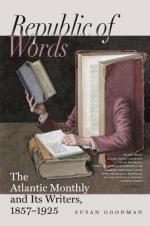Such is the sun-picture, in the form in which we now most commonly meet it,—for the daguerreotype, perfect and cheap as it is, and admirably adapted for miniatures, has almost disappeared from the field of landscape, still life, architecture, and genre painting, to make room for the photograph. Mr. Whipple tells us that even now he takes a much greater number of miniature portraits on metal than on paper; and yet, except occasionally a statue, it is rare to see anything besides a portrait shown in a daguerreotype. But the greatest number of sun-pictures we see are the photographs which are intended to be looked at with the aid of the instrument we are next to describe, and to the stimulus of which the recent vast extension of photographic copies of Nature and Art is mainly owing.
3. THE STEREOSCOPE.—This instrument was invented by Professor Wheatstone, and first described by him in 1838. It was only a year after this that M. Daguerre made known his discovery in Paris; and almost at the same time Mr. Fox Talbot sent his communication to the Royal Society, giving an account of his method of obtaining pictures on paper by the action of light. Iodine was discovered in 1811, bromine in 1826, chloroform in 1831, gun-cotton, from which collodion is made, in 1846, the electro-plating process about the same time with photography; “all things, great and small, working together to produce what seemed at first as delightful, but as fabulous, as Aladdin’s ring, which is now as little suggestive of surprise as our daily bread.”
A stereoscope is an instrument which makes surfaces look solid. All pictures in which perspective and light and shade are properly managed, have more or less of the effect of solidity; but by this instrument that effect is so heightened as to produce an appearance of reality which cheats the senses with its seeming truth.
There is good reason to believe that the appreciation of solidity by the eye is purely a matter of education. The famous case of a young man who underwent the operation of couching for cataract, related by Cheselden, and a similar one reported in the Appendix to Mueller’s Physiology, go to prove that everything is seen only as a superficial extension, until the other senses have taught the eye to recognize depth, or the third dimension, which gives solidity, by converging outlines, distribution of light and shade, change of size, and of the texture of surfaces. Cheselden’s patient thought “all objects whatever touched his eyes, as what he felt did his skin.” The patient whose case is reported by Mueller could not tell the form of a cube held obliquely before his eye from that of a flat piece of pasteboard presenting the same outline. Each of these patients saw only with one eye,—the other being destroyed, in one case, and not restored to sight until long after the first, in the other case. In two months’ time Cheselden’s patient had learned to know solids; in fact, he argued so logically from light and shade and perspective that he felt of pictures, expecting to find reliefs and depressions, and was surprised to discover that they were flat surfaces. If these patients had suddenly recovered the sight of both eyes, they would probably have learned to recognize solids more easily and speedily.




